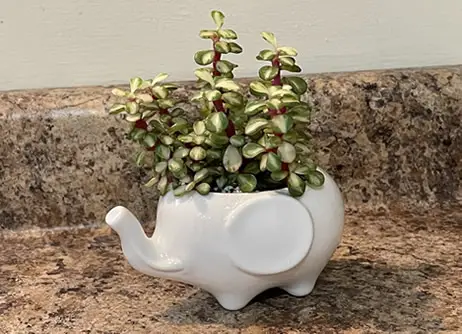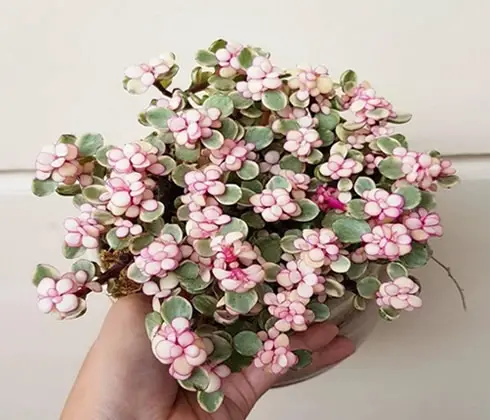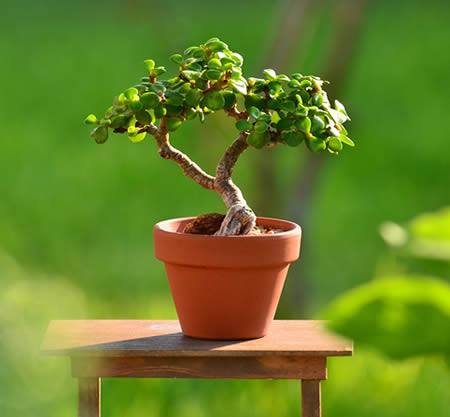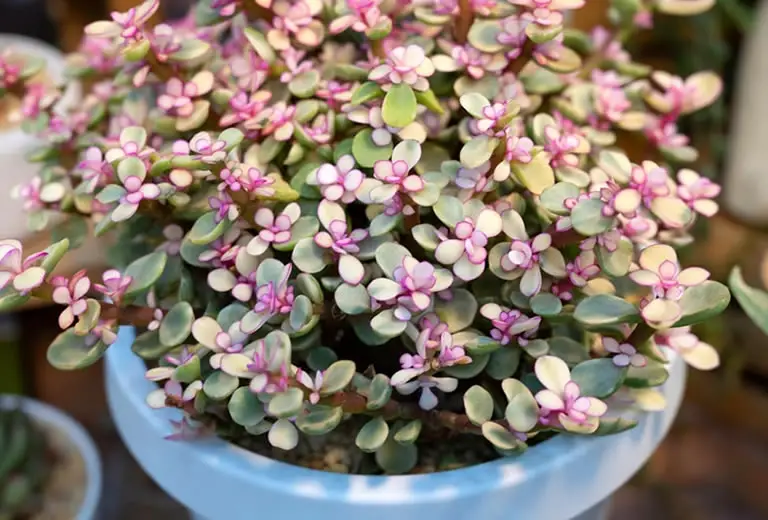With its tiny round leaves, red stems, and bushy growth habit, Elephant Bush (Portulacaria afra) is a charming succulent that brings structure and elegance to any collection. Often mistaken for a jade plant, it’s actually more forgiving and faster growing, making it perfect for both beginners and bonsai lovers.
Native to South Africa, Elephant Bush is sometimes referred to as “Dwarf Jade,” “Mini Jade,” or “Spekboom.” It grows as a low shrub in the wild and is famously known as a food source for elephants—hence the name.
Let’s dive into how to grow this versatile, low-maintenance plant successfully indoors and outdoors.
Table of Contents
- Portulacaria afra
- Light Requirements: Bright Light or Gentle Full Sun
- Watering: Deep and Infrequent
- Soil and Potting: Fast-Draining Is a Must
- Fertilizer: Light Feeding in Spring and Summer
- Pruning and Maintenance: Shaping and Refreshing
- Best Spot in the Home
- Outdoor Elephant Bush Care
- Common Problems and Fixes
- Final Thoughts
Portulacaria afra
Portulacaria afra is a semi-succulent shrub native to the dry regions of South Africa.
In its native habitat, it can grow up to 15 feet tall, forming dense thickets and playing an important role in carbon sequestration and erosion control.

Although often compared to Crassula ovata (jade plant), Elephant Bush is lighter in structure, with smaller, thinner leaves and more flexible stems. It’s a favorite for use in bonsai, hanging baskets, and succulent arrangements.
This plant is a member of the Didiereaceae family—not the Crassulaceae family where most succulents belong—which adds to its unique character and slightly different care needs.
Light Requirements: Bright Light or Gentle Full Sun
Elephant Bush thrives in bright, indirect sunlight but also adapts well to full sun, especially when grown outdoors.
Indoors, place it in a south- or east-facing window for at least 4–6 hours of light daily.
If your Elephant Bush starts stretching or dropping leaves, it’s likely not getting enough light.
Gradually introduce it to more sun to avoid scorching the leaves.
In warmer climates, it can be grown outside in full sun, but it benefits from light afternoon shade during the hottest summer months.
Watering: Deep and Infrequent
As a semi-succulent, Elephant Bush prefers the “soak and dry” method.
Let the soil dry out completely between waterings, then water thoroughly until water drains from the bottom of the pot.
In summer, this may mean watering every 10–14 days. In winter, when growth slows, you may only need to water once every 3–4 weeks.
Overwatering can lead to root rot, while underwatering may cause leaf drop.
This plant bounces back quickly once corrected, making it especially forgiving.
Soil and Potting: Fast-Draining Is a Must
Elephant Bush needs well-draining soil to avoid soggy roots.

A commercial cactus or succulent mix is ideal.
You can also make your own mix with:
-
2 parts potting soil
-
1 part perlite or pumice
-
1 part coarse sand
Use pots with drainage holes, and consider a terracotta container to help wick away moisture more quickly.
Repot every 2–3 years or when the plant becomes root-bound.
Spring is the best time to repot.
Fertilizer: Light Feeding in Spring and Summer
Feed your Elephant Bush during the growing season (spring through early fall) with a balanced succulent fertilizer diluted to half strength.
Look for an NPK around 10-10-10 or 5-10-5.
Feed once a month at most and stop fertilizing in winter.
Avoid high-nitrogen fertilizers, which can cause overly soft growth and reduce the plant’s structural strength.
Pruning and Maintenance: Shaping and Refreshing
Elephant Bush is easy to prune and responds well to shaping.
Use clean scissors or pruners to trim back leggy stems, encourage bushier growth, or create a bonsai structure.
Remove any dead or shriveled leaves as needed.
Cuttings can be propagated easily (more on that in a separate guide).
Pruning is best done in spring or summer when the plant is actively growing.
Consider using healthy cuttings to grow new plants as we outline in the article Elephant Bush Propagation: How to Multiply Portulacaria afra the Easy Way.
Best Spot in the Home
Elephant Bush is ideal for bright kitchens, sunrooms, living rooms, or home offices with strong light.
It also grows well in hanging pots where it can trail gracefully over the edge.
If you enjoy training plants, it makes a wonderful small indoor bonsai or a centerpiece succulent for sunny shelves.
Outdoor Elephant Bush Care
In USDA zones 9–11, Elephant Bush can be grown outdoors year-round.
In cooler regions, it’s best kept in containers that can be moved indoors before frost.
Plant it in sandy, well-draining soil in full sun to light shade.
Outdoors, it thrives in rock gardens, dry slopes, and xeriscape landscapes.

Water sparingly and avoid planting in areas with poor drainage.
Once established, it is extremely drought-tolerant.
Elephant Bush is also deer-resistant and an excellent choice for eco-friendly gardens.
Common Problems and Fixes
Leaf drop
Often caused by sudden changes in temperature or light. Also occurs with over- or underwatering.
Check your care routine and adjust slowly.
Wrinkled leaves
A sign of underwatering. Water deeply and consistently to restore hydration.
Mushy stems or black spots
Indicate overwatering and potential root rot. Remove affected areas and repot in dry, fast-draining soil.
Stretching or leggy growth
Caused by low light. Move the plant to a brighter location or supplement with a grow light.
Pests (mealybugs, aphids)
Rare, but possible. Remove with a cotton swab dipped in alcohol or spray with neem oil.
Final Thoughts
Elephant Bush is a beautifully structured, easy-to-care-for plant that suits both beginners and succulent enthusiasts alike.
Its fast growth, adaptability, and bonsai potential make it a standout addition to any space—indoors or out.
With bright light, dry soil, and a bit of pruning, Portulacaria afra will reward you with a healthy, bushy display that’s both elegant and enduring.

